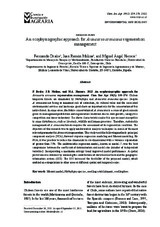An ecophysiographic approach for Araucaria araucana regeneration management

Ver/
Autor
Drake Aranda, Fernando
Molina, Juan Ramón
Herrera Machuca, Miguel Ángel
Editor
Pontificia Universidad Católica de ChileFecha
2012Materia
Nothofagus speciesMaxent model
Seedling establishment
Seedling tree
METS:
Mostrar el registro METSPREMIS:
Mostrar el registro PREMISMetadatos
Mostrar el registro completo del ítemResumen
Chilean
temperate forests are dominated by Nothofagus and Araucaria araucana species. Despite
A. araucana not being at imminent risk of extinction, its cultural value and the associated
environmental services and landscape goods have an important role for the conservation of this
native forest. In some areas, the future conservation of A. araucana is a cause of great concern
given its management prohibition and regeneration limitation due to slow growth, canopy tree
competition and dense understory. The above characteristics make this species most susceptible
to some disturbances, such as livestock, wildlife and human pressures. Therefore, sustainable
management of A. araucana forests requires the assessment of its regeneration condition. The
objective of this research was to apply multivariable analysis techniques in search of the most
relevant parameter for Araucaria regeneration. This study used the following methods: principal
component analysis (PCA), forward stepwise regression modeling and Maxent modeling. By
PCA, it was possible to reduce the dimension to six-dimensional with a variance explanation
of greater than 75%. The multivariable regression model, known as model 7, was the best
compromise between the coefficient of determination and model size (number of independent
variables). Incorporating a maximum entropy trend improved model performance. A spatial
prediction was obtained by summing the contributions of statistical methods and the geographic
information system (GIS). The GIS increased the flexibility of the proposed model, which
enabled an extrapolation to other areas at different spatial and temporal scales.
